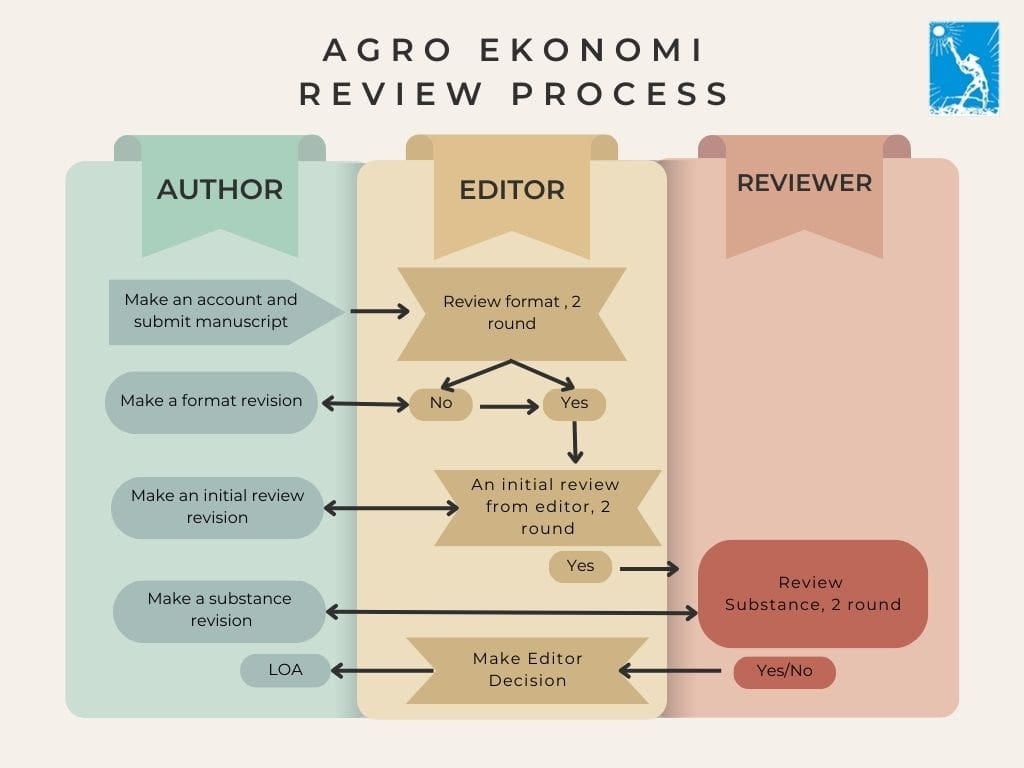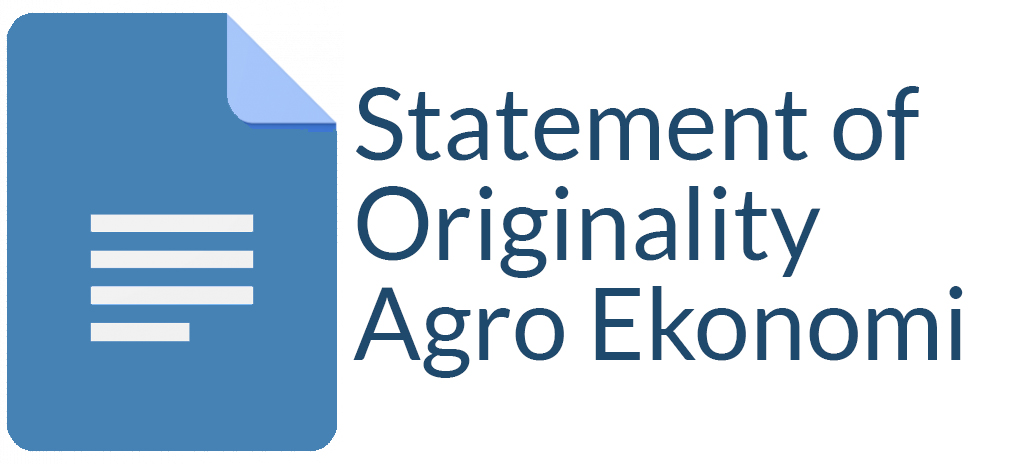Hypothesis Testing on Environmental Kuznets Curve of Agricultural Sector in Java Island: Panel Data Analysis
Ali Hasyim Al rosyid(1*), Irham Irham(2), Jangkung Handoyo Mulyo(3)
(1) Student of Postgraduate Program of Faculty of Agriculture, Universitas Gadjah Mada
(2) Asia-Pacifi c Study Centre (PSAP), Universitas Gadjah Mada
(3) Population and Policy Studies Center (PSKK), Universitas Gadjah Mada
(*) Corresponding Author
Abstract
One obstacle in the improvement of community welfare in the agricultural sector, especially in Java, is the environmental externality which constantly exists in every economic activity. The objective of this research was to estimate greenhouse gas emission coming from agricultural sector in Java and identify whether farmers in Java had allocated environmental conservation costs as the impact of greenhouse gas emission from agricultural activities in Java. The inventory method of greenhouse gas emission from agricultural sector is based on inventory guidelines published by IPCC (Intergovernmental Panel on Climate Change) in 2006. As for the analysis to determine the relationship between greenhouse gas emission and GRDP of agricultural subsector per agricultural labor, The Environmental Kuznets Curve (EKC) was employed, alongside greenhouse gas emission indicators representing environmental degradation and GRDP of agricultural subsector per agricultural worker representing of per capita income of agricultural. Overall, greenhouse gas emissions, both CH4 methane emissions and carbon dioxide emission (CO2) - produced from rice cultivation, fertilizer application, livestock enteric fermentation and poultry manure - are gradually increasing. And the relationship between greenhouse gas emission and GRDP per worker has inverted-U shape; and it is in line with EKC hypothesis. Thereby, the role of the entire community elements and government support in implementing mitigation technology and agricultural adaptation is needed to cope with impacts of greenhouse gas emission, such as climate change.
Keywords
Full Text:
PDFReferences
Apergis. N. C., Christina. G., Rangan. 2017. Are there Environmental Kuznets Curve for US state-level CO2 emissions?. Renewable and Sustainable Energy Reviews (69): 551-558.
Ariani, M., Setyono, P., Ardiansyah, M.. 2016. Biaya Pengurangan (Marginal Abatement Cost) Emisi Gas Rumah Kaca (GRK) Sektor Pertanian di Kabupaten Grobogan dan Tanjung Jabung Timur. Jurnal Ilmu Lingkungan (14) :39-49.
Azam, M. and K., Abdul Qayyum. 2016. Testing the Environmental Kuzets Curve Hypothesis: A comparative empirical study for low, lower middle, upper middle and high income countries. Renewable and Sustainable Energy Reviews (63): 556-567.
Dasgupta, S., Laplante, B., Wang, H., dan David Wheeler. 2002. Confronting the Enviromental Kuznets Curve . The Journal Of Economic Perspective (1): 147-168.
De Bruyn, S.M., Van den Bergh, J.C., dan J.B. Opschoor 1998. Economic Growth and Emissions: reconsidering the empirical basis of environmental Kuznets curve. Ecological Economics (25): 161-175.
Dinda, S. 2004. Enviromental Kuznets Curve Hypothesis: A Survey. Ecological Economics, (49) :431-455.
Everett, T., Ishwaran., G.P. Ansaloni, dan A. Rubin. 2010. Economic Growth an Environment. Unich Personal RePEc Archive 23585.
Farhani, Sahbi, Mrizak, Sana, Chaibi, Anissa, Rault, Christophe. 2014. The environmental Kuznets curve and sustainability: A panel data analysis. Energy Policy (71): 189-198.
Gujarati, D. 2006. Dasar-dasar Ekonometrika. Jilid 2. Jakarta : Erlangga.
Gustiar, F., Suwignyo, R.A., Suheryanto, Munandar. 2014. Reduksi Gas Metan (CH4) dengan Meningkatkan Komposisi Konstentrat dalam Pakan Ternak Sapi. Jurnal Peternakan Sriwijaya (1): 14-24.
Herawati, T. 2012. Refleksi Sosial dari Mitigasi Emisi Gas Rumah Kaca pada Sektor Peternakan di Indonesia. Wartazoa (1): 35-46.
IPCC. 2006. Guidelines for National Green House Gas Inventories, Chapter 10: Emissions from Livestock and Manure Management.
Irham, 2002. Pencemaran Lingkungan dan Aplikasi Kebijakan Pengendaliannya. Jurnal Agroekonomi (1):8-15.
Kartikawati R., Susilawati, H.L., Ariani, M., Setyanto, P. 2011. Teknologi Mitigasi Gas Rumah Kaca dari Lahan Sawah. Jurnal Badan Penelitian dan Pengembangan Pertanian (34):3-8.
Lau, L., Choong, C., Eng, Y., 2014. Investigation of the Environmental Kuznets Curve for carbon emissions in Malaysia: Do foreign direct investment and trade matter?. Energy Policy (68): 490-497.
Lestari, A. dan Setyawan, Y. 2017. Analisis Regresi Data Panel untuk Mengetahui Faktor yang Mempengaruhi Belanja Daerah Provinsi Jawa Tengah. Jurnal Statistika Industri dan Komputasi (1) :1-11.
Sass, R.I. and Cecinore, R.J. 1999. Photosynthate allocations in rice plants: food production or athmosferic methane. http://www.pans.org. [May 24th 2017].
Schutz, H., Seiler, W., and Rennenberg, W. 1990. Soil and land use related souces and sinks of methane (CH4) in context of the global methane budget. In A.F. Bouwman (Ed.). Soils and the Greenhouse Effect., Chichester, New York, Brisbane, Toronto, Singapore : John Wiley and Sons.
Song, T., T. Zheng., dan L. Thong. 2008. An Empirical Test of The Enviromental Kuznets Curve in China: A Panel Cointegration Approach. China Economic Review (199): 381-392.
Suarsana, M. and Wahyuni, P.S., 2011. Global Warming: Ancaman Nyata Sektor Pertanian dan Upaya Mengatasi Kadar CO2 Atmosfer. Jurnal Sains dan Teknologi (11):31-46.
Wang, Y. Han, R. Kobota, J. 2016. Is there an Environmental Kuznets Curve for SO2 emissions? A semi-parametric panel data analysis for China. Renewable and Sustainable Energy Reviews (54):1182-1188.
Widarjono, A. 2009. Ekonometrika, Pengantar dan Aplikasinya. Yogyakarta : Penerbit Ekonisia, Fakultas Ekonomi UII.
Wihardjaka, A. 2001. Emisi Gas Metan di Tanah Sawah Irigasi dengan Pemberian Beberapa Bahan Organik. Agrivita. 23(1):43-51.
Article Metrics
Refbacks
- There are currently no refbacks.
Copyright (c) 2017 Agro Ekonomi

This work is licensed under a Creative Commons Attribution-ShareAlike 4.0 International License.
View My Stats











